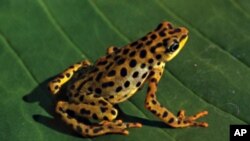Research teams have fanned out across the globe in search of frogs that haven't been seen for at least a decade.
The coordinated hunt into remote forests, swampy fields and dark caves underscores the rapid decline of amphibians and the urgent need to protect them. Robin Moore heads the Search for the Lost Frogs Campaign, sponsored by Conservation International and the International Union for Conservation of Nature.
He says among the most curious on the list is the once abundant Golden Toad which lived in a protected area of Costa Rica and disappeared in a little over a year.
"In 1989, one individual male turned up at a pool waiting for mates to breed. And that was the last individual ever seen," he says.
Teams are also looking for the Gastric Brooding Frog, last spotted in 1985. Moore says what's unique about this Australian amphibian is its way of breeding. "The females actually swallow the eggs and they develop in her stomach into small frogs which then hatch out through her mouth."
Other amphibians with colorful names like the Scarlet Frog from Venezuela, the Hula Painted Frog from Israel and the Rio Pescado Stubfoot Toad from Ecuador have been given their own search teams. But the outlook is not bright.
One-third of the world's more than 6,000 amphibian species are threatened with extinction, due to disease, habitat loss, pollution and climate change.
Despite the odds, Moore says some teams have confirmed rediscoveries including the small brown Ivory Coast Mt. Nimba Reed Frog, last seen in 1967.
"It's a huge discovery from a scientific and conservation perspective for the team and for us."
But Ivory Coast scientist N'Goran Kouama, who found the frog in a swampy field, worries that if people continue to destroy its habitat the frog will truly vanish. He says its rediscovery promotes a sense of pride over unique African resources. "[It shows] to everyone that we have a heritage here and we must protect it."
The Mt. Nimba Reed Frog was one of three species rediscovered in recent weeks, along with the pink-footed Cave Splayfoot salamander in Mexico and the florescent spotted Omaniundu Reed Frog in the Democratic Republic of Congo.
Moore says the amphibians provide important clues about why some species have survived and others have not.
More importantly, he adds their survival also draws attention to the benefits that a healthy ecosystem provides, not only for frogs, but for people. "[They help] regulate things such as fresh water, rainfall. It's really our support system and we need to take care of it, not just for its good, but for our good as well."
Amphibians also help control insects that spread disease and damage crops. The chemicals in their skins have been important in helping to create new drugs. Although the global campaign ends this month, it has spawned country specific projects that will continue the search while also promoting conservation.













